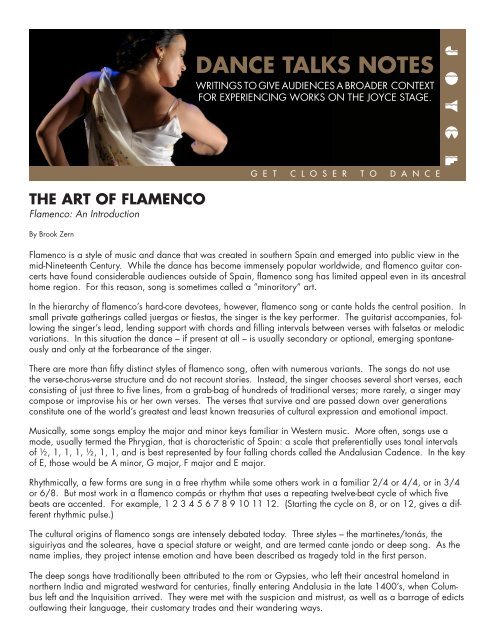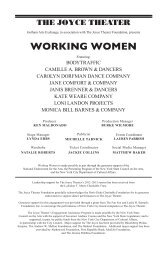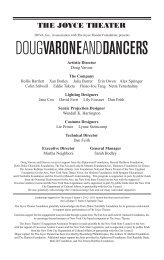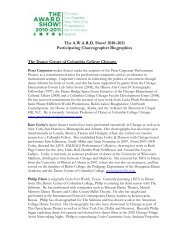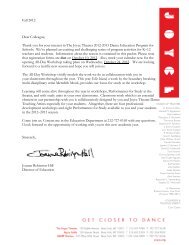Create successful ePaper yourself
Turn your PDF publications into a flip-book with our unique Google optimized e-Paper software.
<strong>DANCE</strong> <strong>TALKS</strong> <strong>NOTES</strong><br />
WRITINGS TO GIVE AUDIENCES A BROADER CONTEXT<br />
FOR EXPERIENCING WORKS ON THE JOYCE STAGE.<br />
THE ART OF FLAMENCO<br />
Flamenco: An Introduction<br />
By Brook Zern<br />
G E T C L O S E R T O D A N C E<br />
Flamenco is a style of music and dance that was created in southern Spain and emerged into public view in the<br />
mid-Nineteenth Century. While the dance has become immensely popular worldwide, and flamenco guitar concerts<br />
have found considerable audiences outside of Spain, flamenco song has limited appeal even in its ancestral<br />
home region. For this reason, song is sometimes called a “minoritory” art.<br />
In the hierarchy of flamenco’s hard-core devotees, however, flamenco song or cante holds the central position. In<br />
small private gatherings called juergas or fiestas, the singer is the key performer. The guitarist accompanies, following<br />
the singer’s lead, lending support with chords and filling intervals between verses with falsetas or melodic<br />
variations. In this situation the dance – if present at all – is usually secondary or optional, emerging spontaneously<br />
and only at the forbearance of the singer.<br />
There are more than fifty distinct styles of flamenco song, often with numerous variants. The songs do not use<br />
the verse-chorus-verse structure and do not recount stories. Instead, the singer chooses several short verses, each<br />
consisting of just three to five lines, from a grab-bag of hundreds of traditional verses; more rarely, a singer may<br />
compose or improvise his or her own verses. The verses that survive and are passed down over generations<br />
constitute one of the world’s greatest and least known treasuries of cultural expression and emotional impact.<br />
Musically, some songs employ the major and minor keys familiar in Western music. More often, songs use a<br />
mode, usually termed the Phrygian, that is characteristic of Spain: a scale that preferentially uses tonal intervals<br />
of ½, 1, 1, 1, ½, 1, 1, and is best represented by four falling chords called the Andalusian Cadence. In the key<br />
of E, those would be A minor, G major, F major and E major.<br />
Rhythmically, a few forms are sung in a free rhythm while some others work in a familiar 2/4 or 4/4, or in 3/4<br />
or 6/8. But most work in a flamenco compás or rhythm that uses a repeating twelve-beat cycle of which five<br />
beats are accented. For example, 1 2 3 4 5 6 7 8 9 10 11 12. (Starting the cycle on 8, or on 12, gives a different<br />
rhythmic pulse.)<br />
The cultural origins of flamenco songs are intensely debated today. Three styles – the martinetes/tonás, the<br />
siguiriyas and the soleares, have a special stature or weight, and are termed cante jondo or deep song. As the<br />
name implies, they project intense emotion and have been described as tragedy told in the first person.<br />
The deep songs have traditionally been attributed to the rom or Gypsies, who left their ancestral homeland in<br />
northern India and migrated westward for centuries, finally entering Andalusia in the late 1400’s, when Columbus<br />
left and the Inquisition arrived. They were met with the suspicion and mistrust, as well as a barrage of edicts<br />
outlawing their language, their customary trades and their wandering ways.
Some believe that the following centuries of persecution provided the tragedy and trauma that ultimately generated<br />
the deep songs in Spain, whose verses often describe moments of terror or grief from a victim’s perspective.<br />
They view the deep song as a monumental creation by some Gypsy families and clans in and around Jerez and<br />
Seville – a testament, forged in the ghettos beyond the earshot of outsiders.<br />
Other authorities dismiss that gitanista or “Gypsyist” view as a romantic backstory devoid of documentation.<br />
They believe that flamenco simply didn’t exist before it was described in the press around 1850. Instead, they<br />
say that many influences coalesced into flamenco song at that time.<br />
Two later and lighter forms of flamenco song, the bulerías and the tangos, are also associated with Gypsy<br />
genesis. The bulerías is an incessant presence in flamenco today, both in its traditional form and as a rhythmic<br />
framework for catchy popular songs termed cancion or copla that appeal to a wider audience.<br />
Other flamenco songs include the light and lively cantinas group – major key forms including the alegrías, the<br />
mirabrás, the caracoles, and the romeras. The sprawling fandangos group seems to have sprung from the folky<br />
and rhythmic fandangos de Huelva, which was “aggrandized” when sung slowly and freely. This led to the<br />
creation of the serious and often melodramatic fandangos naturales and then to regional variants including the<br />
granaínas, malagueñas, tarantas, cartageneras, mineras and others<br />
Another group are the cantes de ida y vuelta, or round-trip songs, which incorporate melodies that filtered into<br />
Latin America from Spain, acquired a distinctive Latin lilt and sway, and returned in the early Twentieth Century<br />
as the guajiras, vidalitas, milongas and colombianas.)<br />
Other flamenco song forms include the farruca and the garrotín, influenced by folk songs of Catalonia; the serranas<br />
from the mountains of Andalusia; the caña and the polo, Andalusian songs influenced by Gypsy aspects of<br />
the solea; the peteneras, which may reflect surviving Jewish influences, and the tientos, a majestic elaboration of<br />
the tangos.<br />
Great singers of the past include La Niña de los Peines, Manuel Torre, Antonio Chacon, Manolo Caracol, Antonio<br />
Mairena and others. More recent figures were La Fernanda de Utrera, El Chocolate, Terremoto de Jerez, La<br />
Paquera and the revolutionary Camarón de la Isla whose work with guitarist Paco de Lucía shattered the conventions<br />
of the flamenco tradition. Enrique Morente was another singer who mastered the art and then made radically<br />
different music. Among the living masters are Jose Mercé, Carmen Linares, Miguel Poveda, Manuel Moneo,<br />
El Torta and Manuel Agujetas.<br />
Flamenco dance is a way of interpreting all of the art’s rhythmic forms (and recently, some of the free-rhythm<br />
forms). The dance sometimes surges up spontaneously as untrained people feel impelled to respond to the pulse<br />
of a flamenco performance – usually a bulerías. That aspect of flamenco is often seen during the encore segment<br />
of a troupe’s performance, when everyone including the accompanists takes a star turn.<br />
But flamenco dance is above all a highly developed art. It seems to spring from the Spanish earth, recalling the<br />
centuries of Moorish occupation, the simple folk dance forms of the earliest fandangos and verdiales, the dignity<br />
of Spain’s formal court dances, the weight of poverty and oppression seen in the soleá, or the lightness, energy<br />
and sheer joy that still shines in the alegrías.<br />
Over time, flamenco dance evolved toward a greater majesty, as techniques became more complex and the differences<br />
between feminine and masculine dance became codified.<br />
The woman’s dance was more reposed, focusing on the arms and head while the feet smoothly marked the<br />
rhythm. The arms were raised high above the head while the hands turned from the wrist in smooth twisting motions<br />
to further accentuate the expressive line of the arms.<br />
Violent, abrupt movement of the body was rare. The bata de cola – the flamenco dress with a long train – was<br />
introduced. The skirt scarcely moved at all, rarely rising above the ground. The emphasis was on garbo, elegance<br />
and grace.
Male dancers emphasized virile footwork, notably in the farruca, the garrotín and the zapateado, the only dance<br />
form without an associated song.<br />
The dance became increasingly theatrical and popular in the 1940’s and 50’s, as troupes led by Carmen Amaya,<br />
Jose Greco, Pilar Lopez, the great Antonio and others conquered the world.<br />
The advent of so-called Ballet Flamenco placed the art on an even higher level. But it also transformed the<br />
dance, with emphasis on collective rather than individual performance. Antonio Gades and Mario Maya pioneered<br />
the use of a company to tell a story, and this has become prevalent.<br />
Today there are many hugely talented flamenco dancers and troupes: Eva Yerbabuena, Rocío Molina, Farruquito,<br />
Manuela Carrasco, Soledad Barrio, and Israel Galván, among others. As traditional boundaries fall,<br />
new realms without losing the immense power and impact that it has inherited from the great masters of the past.<br />
These artists have unprecedented creative freedom. They also face enormous challenges.<br />
The flamenco guitar has evolved enormously, from its progenitor Ramon Montoya to other giants including Niño<br />
Ricardo, Melchor de Marchena, Juan Maya and Diego del Gastor. The concert tradition was long in the hands<br />
of the great virtuoso Sabicas, his brilliant friend and admirer Mario Escudero and the more popular Carlos<br />
Montoya, all of whom moved from Spain to New York to seek an audience for solo guitar, which was not appreciated<br />
in Spain.<br />
The virtuoso guitar is now the property of the incomparable creator and incredible technician Paco de Lucía and<br />
his followers, who appear with groups and blend the tradition with elements of jazz, rock and other musical<br />
styles. Tomatito, Pepe Habichuela and Gerardo Núñez are among his most notable musical descendants. Other<br />
guitarists have chosen to remain closer to the tradition, including Juan Habichuela, Perico del Lunar hijo, Paco<br />
Cepero and the late, great Moraíto.<br />
(Brook Zern has been chasing flamenco music and dance in Spain for decades and sharing his experiences with<br />
Americans through talks, writings, university teaching, and radio programs.)<br />
Originally published September 2011<br />
Lead corporate support for dance education:<br />
Special support provided by The Walt Disney Company, Con Edison, and the Marsicano Foundation.<br />
This program is supported, in part, by public funds from the New York City Department of Cultural Affairs, in partnership<br />
with the City Council.<br />
Photo: Soledad Barrio by Andres Delia


